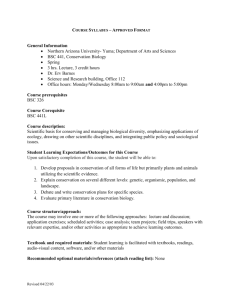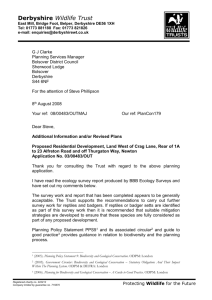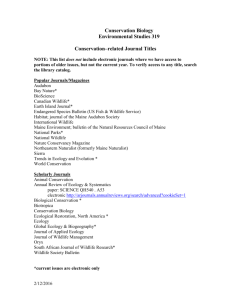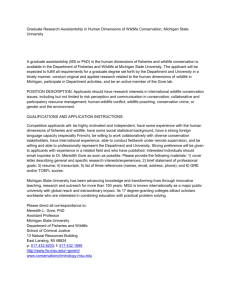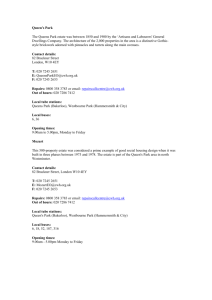Proposed Guidelines for Identification of Critical Wildlife Habitats in
advertisement
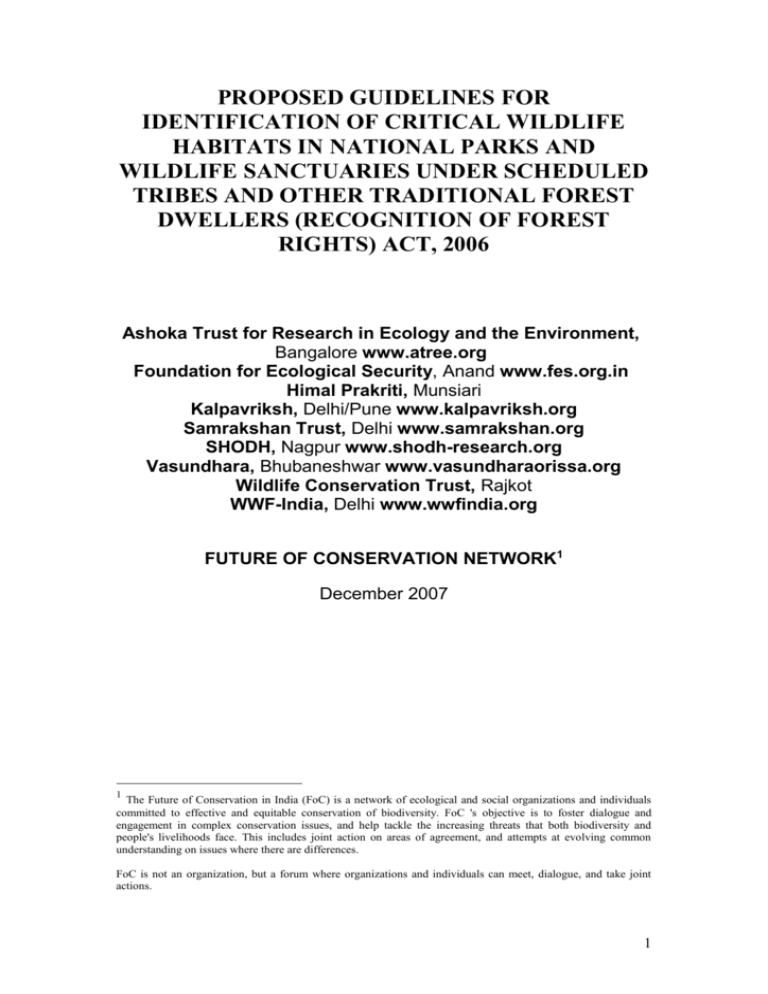
PROPOSED GUIDELINES FOR IDENTIFICATION OF CRITICAL WILDLIFE HABITATS IN NATIONAL PARKS AND WILDLIFE SANCTUARIES UNDER SCHEDULED TRIBES AND OTHER TRADITIONAL FOREST DWELLERS (RECOGNITION OF FOREST RIGHTS) ACT, 2006 Ashoka Trust for Research in Ecology and the Environment, Bangalore www.atree.org Foundation for Ecological Security, Anand www.fes.org.in Himal Prakriti, Munsiari Kalpavriksh, Delhi/Pune www.kalpavriksh.org Samrakshan Trust, Delhi www.samrakshan.org SHODH, Nagpur www.shodh-research.org Vasundhara, Bhubaneshwar www.vasundharaorissa.org Wildlife Conservation Trust, Rajkot WWF-India, Delhi www.wwfindia.org FUTURE OF CONSERVATION NETWORK1 December 2007 1 The Future of Conservation in India (FoC) is a network of ecological and social organizations and individuals committed to effective and equitable conservation of biodiversity. FoC 's objective is to foster dialogue and engagement in complex conservation issues, and help tackle the increasing threats that both biodiversity and people's livelihoods face. This includes joint action on areas of agreement, and attempts at evolving common understanding on issues where there are differences. FoC is not an organization, but a forum where organizations and individuals can meet, dialogue, and take joint actions. 1 Introduction The Scheduled Tribes and Other Traditional Forest Dwellers (Recognition of Forest Rights) Act, 2006 (hereafter referred to as STOTFDA) provides for identification of critical wildlife habitats (CWH) in existing and proposed National Parks and Wildlife Sanctuaries. This is for the purposes of making such CWH inviolate2. In such areas that are designated as critical wildlife habitat, the STOTFDA provides for voluntary relocation of human settlements, or to pursue strategies of co-existence along with specified and negotiated curtailment of rights. Given (a) the large number of protected areas located in diverse biogeographical and eco-climatic zones ranging from cold and hot deserts to tropical evergreen forests, coastal, marine and mangrove ecosystem; (b) the diversity of ecosystems, species and ecological communities involved; (c) the huge pressures of industrial development related biomass extraction, mining, deforestation, change of land use and fragmentation of habitats for several types of development projects including dams, canals and roads, pressure of local hunting and human settlements within and around, and (d) the many traditions of conservation and sustainable use amongst populations traditionally dwelling in or using such areas, the task of identifying critical wildlife habitat should be informed by the best science and traditional or local community knowledge, based on the precautionary principle (Myers, 1993). The next task is to secure such areas against threats, in ways that are democratic and socially just. This process needs to be seen in the context of larger conservation strategies. It is clear from existing scientific research and local community knowledge that a mix of approaches is needed to secure wildlife and ecosystems across India’s landmass, including no-use, minimal use, and multiple-use areas. Increasingly, there is growing scientific evidence and support for maintaining diverse landscapes as production landscapes rather than islands of protected areas with zero production surrounded by an over-exploited production landscape (Bengtsson et al., 2003). In some cases, there is a need for reserves and off-limits areas that can serve as breeding grounds, seedbanks, sources of dispersal agents and the generators of essential regulating and maintenance services for the larger socio-ecological landscape (Elmqvist et al., 2003). Criteria for identifying CWH 1. This will apply to all existing PAs with first notification issued and for all new PAs. Tiger Reserves and other important sites for tigers are excluded from the purview of this note, as they have already been covered under the NTCA exercise for which a separate note has been prepared and submitted 3. Wildlife 2 ‘Inviolate areas’ can be defined as those within which there will be either no human activity allowed, or only minimal human activity is allowed that is not a threat to species or ecological communities; such minimal activities could include resource use, protection, tourism, and research. 3 Proposed Guidelines on Identification Of Critical Tiger Habitats, Co-Existence, and Relocation Related To Tiger Reserves (In Pursuance Of The WLPA as Amended In 2006). Suggestions to the National Tiger Conservation Authority. Ashoka Trust for Research in Ecology and the Environment, Council for Social Development, Himal Prakriti, Kalpavriksh, Samrakshan, SHODH, Vasundhara, Wildlife Conservation Trust, WWF-India. September 2007 2 includes all uncultivated wild flora and undomesticated fauna. 2. In many cases, the entire PA could be identified as critical wildlife habitat and in other cases, the area identified as such will be a part or parts of the PA, either contiguous or in disjunct area. In such cases, the size of each such part can be specified based on ecological, biological and landscape ecology principles. 3. The decision on which PAs, how much and which parts of a specific PA are to be made inviolate will be made based on certain criteria. These include: conservation value of the site based on criterion such as irreplaceability of the site, complementarity, rarity and endemicity of the biodiversity as well as ecological and biological conservation considerations of maintaining viable meta-populations that requires ecological and genetic connectivity and resilience in the larger landscape. In addition criteria such as presence of Schedule I (or other threatened) species, endemic species, and other such established criteria could also contribute to the designation of an entire PA or sufficient parts of it as critical wildlife habitat. The decision should also be based on what is feasible given socio-economic factors and the process of relocating bona fide rights holders under the Act. This second criteria is especially (but not only) relevant where the number of people affected is large, or the human communities involved are especially vulnerable. 4. The levels and kinds of human uses that need to be curtailed and those that could continue inside identified CWHs would vary, and should be based on available verified knowledge (modern or traditional). CWH to be decided on a case by case basis, with full public participation, as some forms of regulated biomass extraction or human use/management may be compatible with the conservation objectives, or even necessary for the ecological processes that help maintain the habitat for some species or communities. Process for identifying and establishing CWH It is proposed that the exercise be done in three nested, hierarchical stages: In the first stage, a broad national level listing needs to be done, for each biogeographical zone of the country. Based on available prioritization carried out on multiple taxa (e.g. see Das et al., 2006 for the Western Ghats), the first shortlist of protected areas that are considered the highest priority can be prepared. This stage can be carried out by a committee of scientists/institutions with a track record of credible work and knowledge in biodiversity/wildlife, and should be open to peer and public review for an appropriate time before finalization. In the second stage, this list can be further fine-tuned (and added to, if need be, with sufficient justification), for each state. This stage can be carried out by state level committees comprising of national or local scientists/institutions with a similar track record, local community representatives knowledgeable about landscapes larger than their own locality, and others. 3 In the third stage, final decision should be taken on each PA, i.e. how much of it is to be declared CWH, and the processes for doing so. This stage should be carried out in a fully participatory manner at each PA, involving national/state/local experts and representatives of traditional long-resident and user communities. Sanctuary Advisory Committees as mandated by Section 33b of the Wild Life Protection Act 1972 could be used as a platform to achieve this successfully. A good example of the above process (relevant especially for marine and coastal areas), is the prioritization exercise undertaken for the Great Barrier Reef in Australia; it involved consultation with a wide variety of stakeholders and resulted in ’no-take’ zones, along with multiple use and restricted use zones4. Similar exercises (using stage 3 above) are currently under way for the PAs of Ladakh (collaboratively between NGOs, the Wildlife Dept, and local communities), some PAs in Orissa (by NGOs and local communities), and the Biligiri Rangaswamy Temple Sanctuary of Karnataka (by NGOs and local communities). These guidelines could go a long way in achieving a systematic process to assess which are the most critical areas for conservation, and move towards ways for people to either coexist or consent to be relocated. However, caution should be applied when using the guidelines in complex situations of recent encroachments or settlements such as in northeast India. Both the imperatives of conservation and livelihoods security can be met with such an approach. References and Notes Bengtsson, J., Angelstam, P., Elmqvist, T., Emanuelsson, U., Folke, C., Ihse, M., Moberg, F., and Nyström, M. 2003. Reserves, Resilience and Dynamic Landscapes. Ambio 32: 389–396. Das, A., Krishnaswamy, J., Bawa, K.S., Kiran, M.C., Srinivas, V., Samba Kumar, N., and Karanth, K.U. 2006. Prioritization of Conservation areas in the Western Ghats, India. Biological Conservation 133:16:31. Elmqvist, T., Folke, C., Nyström, M., Peterson, G., Bengtsson, J. et al. 2003. Response diversity, ecosystem change, and resilience. Frontiers in Ecology and the Environment Vol. 1, No. 9 pp. 488–494. Myers, N. 1993. Biodiversity and the precautionary principle. Ambio 22:74-79. 4 Zoning in the Great Barrier Reef. http://www.gbrmpa.gov.au/corp_site/management/zoning; for a history of the zoning, see http://kurrawa.gbrmpa.gov.au/corp_site/management/zoning/rap/rap/index.html 4



